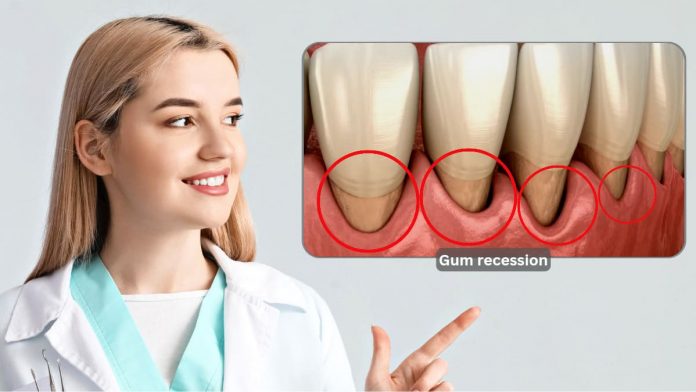Gum recession or gingival recession is the exposure of the root surface by an apical shift of gingival position. Exposed root surface causes sensitivity, and cervical abrasion, and increases the chances of root caries or cavities. In simple words, gingival recession refers to the position of the gingiva or gums and not a condition of the gingiva. It can be localized in a tooth or group or generalized throughout the mouth. It is more common in males than females.
To better understand the gingival recession it is important to know the actual and apparent position of the gingiva. We consider the apparent position of the gingiva to determine the severity of the gingival recession. The actual position is always below the apparent position and it helps to determine the clinical attachment loss. The presence of recession indicates that attachment loss has occurred, but not necessarily that inflammation is present.
Gingival recession increases with age; however, it is not a consequence of physiologic aging but is the cumulative effect of pathologic conditions (For instance, periodontitis) and trauma (For instance, hard toothbrushing). There’s no such evidence has been shown which proves it is a physiological process of aging.
Signs and Symptoms :
- Tooth Sensitivity because of the exposed root surface of teeth.
- The tooth appears longer than usual.
- Tooth root clinically visible.
- Swollen gums, bleeding gums while brushing and flossing.
Causes of Gum Recession :
There are many factors responsible for the gum recession, but if we consider two main factors then they are trauma and pathologic condition.
1. Hard toothbrushing :
It is the most common cause of gums recession. A hard toothbrush can abrade epithelium and creates painful ulcerations. Repeated usage of hard bristled toothbrushes, horizontal toothbrushing, and abrasives in toothpaste not only damages soft tissue but also creates V-shaped notches at the cementoenamel junction because of cervical abrasion. Canines and premolars are more affected.
Individuals who perform aggressive horizontal brushing are often found to have a gingival recession or cervical abrasion on the teeth quadrants contralateral to their dominant hand.
If a patient taking orthodontic treatment with the planned labial displacement of teeth then it is important to change the normal toothbrushing regimen to avoid trauma; a soft brush or EMB is useful in such cases. However, orthodontic treatment is not always and only contributing factor for gingival recession, it may depend on various other factors like thickness of tissue, bony support, condition of the periodontium, etc.
2. Overzealous Flossing :
Incorrect or overzealous flossing causes more damage than benefit. Forceful and aggressive up-down flossing creates cuts into the gingiva called Gingival cleft (also known as flossing cleft). So it is crucial to know and perform flossing in the correct and atraumatic fashion to avoid damage to gingival tissue or gums.
Apart from flossing, there are other interdental aids, such as toothpicks, interdental tips, triangular wood sticks, etc which can also cause damage on improper use. You should know the proper technique of use of interdental aids to get maximum benefits and less trauma to the tissue.
3. Self-Inflicted Injury :
Placing the blunt end of a pen, pencil, or fingernail may cause trauma to the gums leads to recession of gums.
Consumption of tobacco increases the chances of a gingival recession at the site that come in direct contact with the tobacco (chewing tobacco). The incidence of the gingival recession has been reported higher in tobacco consumers in comparison to others. Both smoke and smokeless tobacco are contributing factors to receding gums and poor periodontium health.
4. Occlusion Trauma :
Occlusion trauma is also responsible for gum recession. For instance, Excessive incisal overlap and deep overbite also cause traumatic injury to the gingiva and lead to gingival recession. Grinding teeth or bruxism is also contributing factor to gingival recession.
5. Malpositioned teeth :
Labially positioned teeth, thin alveolar housing, and minimal thickness of the gingival covering are more prone to toothbrushing trauma and ultimately causes gingival recession. Thick bone supports the marginal soft tissue and resists the tendency for recession to occur.
In many cases, bone is absent beneath the thin gingival tissue known as dehiscence, such a condition combined with improper or hard toothbrushing technique leads to recession and root surface exposure. Recession often continues until the soft tissue margin approaches the bone margin where the recession will stop in the absence of inflammation. This phenomenon has been termed a self-limiting recession.
6. Hormonal changes :
Hormonal changes during puberty in both males and females, the chances of gums bleeding increase and normally subsides after puberty.
Changes in female sex hormones throughout life at puberty, menstruation, pregnancy, and menopause cause gums to thin and sensitive and more prone to gum recession.
7. Periodontal disease :
Periodontal diseases like gingivitis, periodontitis weakens the periodontium and is one of the responsible factors for gum recession.
These are the causes, keep your gums healthy to avoid gum recession.

